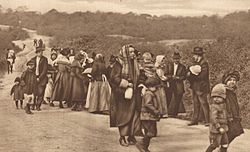Welcome to DU!
The truly grassroots left-of-center political community where regular people, not algorithms, drive the discussions and set the standards.
Join the community:
Create a free account
Support DU (and get rid of ads!):
Become a Star Member
Latest Breaking News
Editorials & Other Articles
General Discussion
The DU Lounge
All Forums
Issue Forums
Culture Forums
Alliance Forums
Region Forums
Support Forums
Help & Search
American History
Related: About this forumOn this day, October 4, 1918, the T. A. Gillespie Company shell loading plant explosions began.
T. A. Gillespie Company Shell Loading Plant explosion
Coordinates: 40°27′42″N 74°17′23″W

Residents evacuating after the explosions
Date: October 4, 1918 to October 6, 1918
Time: 7:36 pm EDT (start)
Location: Sayreville, New Jersey
Coordinates: 40°27′42″N 74°17′23″W
Also known as: Morgan Munitions Depot explosion
Cause: Worker error or (speculative) German sabotage
Participants: US Coast Guard, US Army
Outcome: Plant abandoned following Armistice
Deaths: ~100
Non-fatal injuries: 100+
Missing: ~18
Property damage: Complete destruction of plant ($18 million in 1918); major damage to 300+ buildings in Sayreville, South Amboy, and Perth Amboy, NJ; broken windows for 20 miles (32 km) around.
The T. A. Gillespie Company Shell Loading Plant explosion, sometimes called the Morgan Munitions Depot explosion or similar titles, began at 7:36 pm EDT on Friday, October 4, 1918, at a World War I ammunition plant in the Morgan area of Sayreville in Middlesex County, New Jersey, United States. The initial explosion, generally believed to be accidental, triggered a fire and subsequent series of explosions that continued for three days, totaling approximately six kilotons, killing about 100 people and injuring hundreds more. The facility, one of the largest in the world at the time, was destroyed along with more than 300 surrounding buildings, forcing the evacuation and reconstruction of Sayreville, South Amboy, and Laurence Harbor (Old Bridge). Over a century later, explosive debris continues to surface regularly across a 1.2-mile (1.9 km) radius.
{snip}

Man standing in a large crater from the explosion of 1 million pounds (0.5 kiloton) of stored ammonium nitrate
{snip}
Legacy
{snip}
The sports teams of Sayreville War Memorial High School are named the Sayreville Bombers, recalling the town's World War I ammunition plants and many World War II veterans.
{snip}
Coordinates: 40°27′42″N 74°17′23″W

Residents evacuating after the explosions
Date: October 4, 1918 to October 6, 1918
Time: 7:36 pm EDT (start)
Location: Sayreville, New Jersey
Coordinates: 40°27′42″N 74°17′23″W
Also known as: Morgan Munitions Depot explosion
Cause: Worker error or (speculative) German sabotage
Participants: US Coast Guard, US Army
Outcome: Plant abandoned following Armistice
Deaths: ~100
Non-fatal injuries: 100+
Missing: ~18
Property damage: Complete destruction of plant ($18 million in 1918); major damage to 300+ buildings in Sayreville, South Amboy, and Perth Amboy, NJ; broken windows for 20 miles (32 km) around.
The T. A. Gillespie Company Shell Loading Plant explosion, sometimes called the Morgan Munitions Depot explosion or similar titles, began at 7:36 pm EDT on Friday, October 4, 1918, at a World War I ammunition plant in the Morgan area of Sayreville in Middlesex County, New Jersey, United States. The initial explosion, generally believed to be accidental, triggered a fire and subsequent series of explosions that continued for three days, totaling approximately six kilotons, killing about 100 people and injuring hundreds more. The facility, one of the largest in the world at the time, was destroyed along with more than 300 surrounding buildings, forcing the evacuation and reconstruction of Sayreville, South Amboy, and Laurence Harbor (Old Bridge). Over a century later, explosive debris continues to surface regularly across a 1.2-mile (1.9 km) radius.
{snip}

Man standing in a large crater from the explosion of 1 million pounds (0.5 kiloton) of stored ammonium nitrate
{snip}
Legacy
{snip}
The sports teams of Sayreville War Memorial High School are named the Sayreville Bombers, recalling the town's World War I ammunition plants and many World War II veterans.
{snip}
InfoView thread info, including edit history
TrashPut this thread in your Trash Can (My DU » Trash Can)
BookmarkAdd this thread to your Bookmarks (My DU » Bookmarks)
2 replies, 439 views
ShareGet links to this post and/or share on social media
AlertAlert this post for a rule violation
PowersThere are no powers you can use on this post
EditCannot edit other people's posts
ReplyReply to this post
EditCannot edit other people's posts
Rec (4)
ReplyReply to this post
2 replies
 = new reply since forum marked as read
Highlight:
NoneDon't highlight anything
5 newestHighlight 5 most recent replies
= new reply since forum marked as read
Highlight:
NoneDon't highlight anything
5 newestHighlight 5 most recent replies
On this day, October 4, 1918, the T. A. Gillespie Company shell loading plant explosions began. (Original Post)
mahatmakanejeeves
Oct 2023
OP
bucolic_frolic
(46,730 posts)1. This type of history is being lost
I had an ancestor who worked for a munitions contractor in NJ, prior to WWII. Pollak's of Kearny NJ.
https://www.nytimes.com/1972/07/02/archives/leo-pollaf-89-dies-led-ordnance-firm.html
https://www.ibiblio.org/hyperwar/USN/ref/USN-Act/NJ.html
ProfessorGAC
(69,643 posts)2. I'm Guessing They Were Making Amatol
Amatol is a mixture of ammonium nitrate & TNT. That crater in the picture is the result of an ammonium nitrate exposion.
Amatol was commonly used in depth charges to combine high brisance/high velocity with lower speed/high pressure explosives. Also, used in dam busting.
U-Boats were a problem in WW1, of course. Planes weren't yet capable of dropping dam busters so I'm guessing depth charge manufacturing.